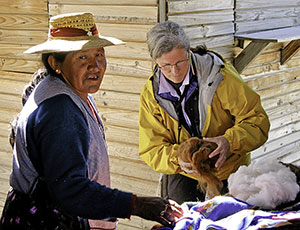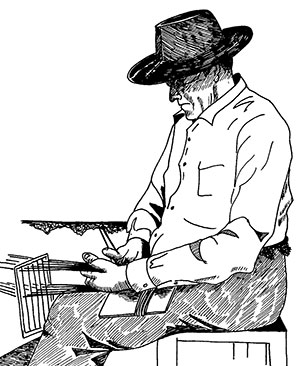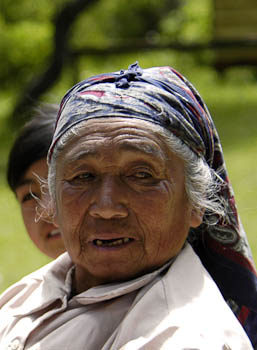WEAVING ANDEAN STORIES:
TRACING ARGENTINA’S CULTURAL HERITAGE
AND TEXTILE TRADITIONS
October 15-30, 2010
16 Days/ 15 Nights
Carol Passera, Audrey Benedict, and Argentine Textile Experts & Artisans
 Andean textiles reflect the fabric of life—a unique heritage of woven stories and cultural traditions inspired by the high, windswept deserts and snow-capped peaks of the Andes. In the ancient Andean world, textiles served as a primary form of artistic expression as well as a powerful visual medium for portraying nature’s secrets and the order of the universe. The Incas believed cosmic harmony required balance in all realms of life— nature-culture, male-female, past-future, front-back, right-left, and top-to-bottom. Textile designs from both pre- and post-Spanish Conquest periods reflect these belief systems, whether destined for ceremonial purposes or for everyday use. Andean textiles reflect the fabric of life—a unique heritage of woven stories and cultural traditions inspired by the high, windswept deserts and snow-capped peaks of the Andes. In the ancient Andean world, textiles served as a primary form of artistic expression as well as a powerful visual medium for portraying nature’s secrets and the order of the universe. The Incas believed cosmic harmony required balance in all realms of life— nature-culture, male-female, past-future, front-back, right-left, and top-to-bottom. Textile designs from both pre- and post-Spanish Conquest periods reflect these belief systems, whether destined for ceremonial purposes or for everyday use.
 In Argentina, the first hand-spun cordage—a mixture of plant fibers, wool, and human hair—dates to nearly 7670 BC and was found in a cave in Jujuy Province. The domestication of native Andean camelids—guanacos, alpacas, llamas, and vicuñas—as a consistent wool source clearly predated the Inca’s cultural ascendency. In fact, woven cloth became such a valuable commodity that it functioned as a status symbol and often took the place of monetary currency. In Argentina, the first hand-spun cordage—a mixture of plant fibers, wool, and human hair—dates to nearly 7670 BC and was found in a cave in Jujuy Province. The domestication of native Andean camelids—guanacos, alpacas, llamas, and vicuñas—as a consistent wool source clearly predated the Inca’s cultural ascendency. In fact, woven cloth became such a valuable commodity that it functioned as a status symbol and often took the place of monetary currency.
The Spanish conquerors, discovering indigenous populations already skilled in the art of weaving, introduced European merino sheep, increased native cotton cultivation, and imposed strict textile guidelines and religious strictures on the weavers—all with the goal of establishing a New World woolen industry that would rival any in Europe. In addition to the skills of the weavers, the Spanish also marveled at the vibrant colors produced by the natural dyes in use at the time— especially the red dyes made from cochineal, a tiny scale insect found on
cactus, and the amazingly rich blues made from a shrub called indigo. Both of these dyestuffs were soon being exported to satisfy Europe’s burgeoning textile industry. Though Spanish textile designs and influences can still be seen in north and northwestern Argentina, the Spaniards never totally succeeded in unraveling the traditions and cultural expression that had persisted—virtually unchanged—for centuries.
View Larger Map
Andean textiles are known worldwide for their exquisite quality, intricate designs, and rich color palette. This unique seminar explores the natural history, human lifeways, wild fiber usage, and textile traditions of two strikingly different regions in Argentina. Our textile odyssey begins in Buenos Aires, with visits to museums, galleries, and lectures by noted textile experts. We fly to the beautiful colonial city of Salta, which serves as a cultural center for the textile arts of Northwest Argentina. From there we’ll travel to the remote, highland communities of Purmamarca and Abrapampa, in the Andean puna, where both Inca and Hispanic influences remain strong and vibrant. We’ll enjoy demonstrations by local weavers and spinners, learn how to dye with native plants, and visit artisan markets to purchase alpaca wool and textile treasures—at the source!
Shifting our focus to Argentine Patagonia, we’ll travel to the heartland of the indigenous  Mapuche people, whose resistance to Spanish influences allowed them to perfect their own weaving style—double-faced textiles highlighted by complicated geometric designs. We’ll visit the Taller Artesanal and the Nahuel Pan artisan markets, where Mapuche women still gather to spin, weave, and sell their beautiful work. From the Mapuche village of Gualjaina, we’ll travel along the Chubut River to the El Saltillo spinning wheel workshop—also learning to spin, with a stick, in the ancient Mapuche manner. We’ll stay at famous Estancia Don Jose, home of the Guenguel Project, where the Maziquiarán family raises a special breed of guanaco and produces luxurious fabrics and garments woven or knitted from yarns that blend the finest quality Merino wool with guanaco. We conclude with a visit to the world-famous Cañon del Rio Pinturas and Cueva de las Manos (“Cave of the Hands”), the cave’s walls covered with hundreds of brightly-colored, positive and negative hand prints, as well as 9,000 year old drawings of humans and guanacos—a true celebration of Andean artistic traditions! Mapuche people, whose resistance to Spanish influences allowed them to perfect their own weaving style—double-faced textiles highlighted by complicated geometric designs. We’ll visit the Taller Artesanal and the Nahuel Pan artisan markets, where Mapuche women still gather to spin, weave, and sell their beautiful work. From the Mapuche village of Gualjaina, we’ll travel along the Chubut River to the El Saltillo spinning wheel workshop—also learning to spin, with a stick, in the ancient Mapuche manner. We’ll stay at famous Estancia Don Jose, home of the Guenguel Project, where the Maziquiarán family raises a special breed of guanaco and produces luxurious fabrics and garments woven or knitted from yarns that blend the finest quality Merino wool with guanaco. We conclude with a visit to the world-famous Cañon del Rio Pinturas and Cueva de las Manos (“Cave of the Hands”), the cave’s walls covered with hundreds of brightly-colored, positive and negative hand prints, as well as 9,000 year old drawings of humans and guanacos—a true celebration of Andean artistic traditions!
Price: $4,850. (includes a $500 deposit)
Group Size: 10
Trip Rating: 2
Price Includes: 16 days/15 nights, including all lodging, all meals, transportation by van or small bus throughout, all lectures and demonstrations by local experts and artisans, entrance fees to museums and exhibits, the services of two naturalist guides, and all airport/hotel transfers.
Does not include roundtrip airfare to and from Buenos Aires (10/15-16 & 10/29-30) from your point of departure, internal flights as required (≈ $650), alcoholic beverages, or personal items.

|
